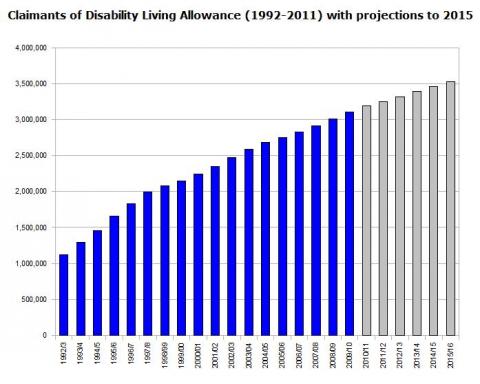Do Iain Duncan Smith's DLA claims ring true?
"We are creating a new benefit, because the last benefit [Disability Living Allowance] grew by something like 30 per cent in the past few years. It's been rising well ahead of any other gauge you might make about illness, sickness, disability or, for that matter, general trends in society."
"Something like 70 per cent [of DLA claimants] had lifetime awards, [which] meant that once they got it you never looked at them again."
Iain Duncan Smith, interview with the Sunday Telegraph, 13 May 2012
The Work and Pensions Secretary Iain Duncan Smith reopened the welfare reform debate over the weekend as he promised not to 'light the fuse on disability reform' in an interview with the Sunday Telegraph.
Join 72,953 people who trust us to check the facts
Sign up to get weekly updates on politics, immigration, health and more.
Subscribe to weekly email newsletters from Full Fact for updates on politics, immigration, health and more. Our fact checks are free to read but not to produce, so you will also get occasional emails about fundraising and other ways you can help. You can unsubscribe at any time. For more information about how we use your data see our Privacy Policy.
According to Mr Duncan Smith, there has been significant growth in the number of people claiming Disability Living Allowance (DLA), with many of those in receipt "never getting looked at again". Is this what the facts say?
Claims up by a third?
It isn't difficult to trace the genesis of Mr Duncan Smith's first claim, and it featured in the March 2011 Impact Assessment for the Government's own Disability Living Allowance Reform proposals. This states:
"In just eight years the numbers claiming Disability Living Allowance has risen from 2.4 million to 3.2 million — an increase of 30%."
And we can see from the Department for Work and Pensions' DLA caseload figures, this overview is broadly accurate, and forms part of a longer term growth stretching back to 1992.

However how this trend compares to "general trends in society" is much more contentious, as at least a portion of the rise claims could be attributed to wider demographic changes.
For example, new DLA claimants are required to be under 65 when they make their claim, however once they have been granted an award they can continue to receive the benefit after they reach their 65th birthday. As time progresses we could therefore expect a degree of natural growth in the caseload.
The DWP has attempted to model the impact that these shifts in demographics may have had on the number of people claiming DLA. It concluded that:
"Demographics account for about a third of this 29% growth. This includes growth due to increases in the population and changes in the age structure of the population due to the ageing of particular cohorts."
However campaigners have argued that even this might overstate the case, and have themselves evaluated the figures in a report titled Responsible Reform (also known as the Spartacus Report). By looking at the claimant rate (the number of people on DLA as a proportion of the working age population) rather than the raw numbers, they have calculated that the growth over the same time period was a more modest 16 per cent.
When broken down into the types of disabling condition the picture is complicated further. As the graph above shows, most of the growth has been driven by increased numbers of applicants receiving support for mental health issues and learning difficulties. This, the report notes, could have been driven by better diagnosis of these types of conditions.
70 per cent of claims for life?
A DWP analysis from last year confirms that 71 per cent of all those receiving DLA do so on an indefinite basis. However this does not necessarily mean that they are no longer in contact with DWP. As the DirectGov website states:
"If your benefit award is for an indefinite period, you will not usually have to make a renewal claim. Indefinite awards can sometimes be reviewed and you may need to have another medical examination as part of the review."
Whether or not this happens in practice is uncertain, as another DWP report from 2009 observes that "assessments of ongoing claims — in essence, 'spot checks' on continuing eligibility — appear to occur infrequently if at all."
It's also important to note that we can only say that 71 per cent of the total caseload of claimants are in receipt of indefinite awards, and this does not mean that a similar proportion of new claims are given indefinite awards.
In fact, acording to the DWP's own research less than a quarter of new claimants receive indefinite awards, with the remainder being given the benefit for a fixed period.
The difference between the two figures can be explained by the fact that, while there is a high turnover in the fixed term claimants, people understandably move on and off indefinite awards at a much slower rate.
Conclusion
Iain Duncan Smith can point to evidence to support both of the claims he makes about the current operation of the Disability Living Allowance, however the significance of each is hotly contested.
While there has been a 30 per cent growth in the raw number of claimants, this is significantly lower once demographic changes are accounted for, and the discrepancies in the relative growth rates of various conditions suggest the link to wider societal trends might be more complex than the Secretary of State acknowledges.
Similarly, while it is true that over 70 per cent of DLA claimants are on indefinite awards, it isn't necessarily true that these people are 'never looked at again'.